Here in New England everyone seems to like to build neo-Greek revival. The original Greek Revival was referencing the original Greek. The first revival was far away from the original in form as well as geographical location and had its own set of clearly defined rules set out in builders guide books. The neo-Greek revival tries to copy the second coming but, too often, without the rules. So to a trained eye (or even not so trained) it generally fails miserably although enough people seem to think its lovely that there is plenty of it around. Point being; there is room for anything in terms of aesthetics and you never know what's going to stick. Give it 100 years and let history be the judge. I suspect that this may prove to be a weird point in history when people wanted new homes that looked old - a steampunk sort of thing. I am starting to see a shift in perspective already. I often work in the Greek revival style because it puts food on the table but also because there is also a lot to learn from it which is applicable to my more modern work. The New England historians remind us that all those old Greek revival village homes look so lovely because they tore down the ones that were ugly. Form and function and beauty are fine and good starting points but as an architect a person who has experienced what happens when architecture goes beyond those three things, I shall never stop trying to achieve that higher goal.Even when people think I'm nuts.
Building Science gives me a headache.
Building Science gives me a headache. I read the usual sites: Greenbuildingadvisor.com, building science.com, plus a few others, I attend seminars, I get all the proper magazines, I belong to the correct organizations such as the USGBC. I'm a good little architect. But I am confused. The more I dive into building science the more questions I have – and therefore the less authoritative I sound in front of clients and I don't think clients want their architect to sound wishy-washy. Let me start by explaining building science. Building science is largely based on large amounts of cumulative experience (databases) probability and statistics. As I recall the story, Joe Lstiburek and his pals started buildingscience.com after going into thousands of houses near airports to upgrade insulation levels to provide better sound proofing. They saw lots of bad things (rot). This provided them with the beginnings of a large database of how houses are built in terms of what works and what doesn't – what details and systems result in greater failure rates as well as what works. A much larger database than Joe builder down the road who has built a few dozen houses in the past thirty years. Smart Joe-the-builders (notice I'm not saying Bob the builder...there's a reason for that...I'm tired of Bob jokes okay?) anyway, smart Joe-the-builders recognize that Joe-the-building-scientist has collected way more information and experience all in one place and is offering it out for free – or just about. Smart Joe-the-builders know that construction is a high liability proposition and anything they can do to limit that liability will help them sleep at night. You can probably replace Joe-the-builder with Bob-the-architect in the previous sentences and it would work fairly well. These Joe-the-building-scientist types are also very often engineers (which means they look at numbers a lot and when they build houses for themselves they cannot justify having windows because it blows their heat loss calculations right out...well...the window) Being numbery-engineery sorts they are able to take their observations from the databases of thousands of houses and figure out more specifically what is happening to cause the problems. Thus we have much more information now about, for instance, the importance of air sealing, controlled ventilation and gapping the siding away from the sheathing than we did ten years ago.
As an architect, fabulous new products come across my desk every day and the magazines are filled with advertisements. How to sort through all this? We architects look to building science to help us separate the wheat from the chaff. Who has done a study on this new and great sounding product? Was the study valid enough to take seriously? What is the builder input and reaction to this new product? What are the warranties? What is the science that the amazing claims are based upon. As an architect I realize that there is always someone with way more expertise and experience than myself and part of my job is to seek them out.
My thoughts along these lines started as an ongoing conversation with an equally confused builder friend of mine. This builder is a rare one who drags his crew to building science talks and seminars and is buddies with Alex Wilson et. al. over at Building Green. We have been trying to figure out what is the perfect enclosure for our local climate in terms of: Ease of construction – what can the carpenters understand and get behind? Budget constraints – most clients around here are have very limited budgets and just want more room; green building and lower heat bills through super-insulation are secondary. Simplicity – this cannot be understated as it affects all other issues. Use of commonly available and understood building materials and systems. Performance – why put tons of insulation in a wall if there is inadequate air sealing which renders the insulation nearly useless? So far, it has been our local experience that proprietary systems cost, at least marginally, more. There are some very good systems out there it should be noted, all with their share of positives and negatives What has a proven track record of performance with building science to back it up. Does a less than perfect installation negate any advantages or potentially cause more issues than a business as usual system of construction? How much of a difference is it really going to make – This may need some explaining and I will use the example of my own house. I burn about 4 cord of wood per year to stay cozy and warm. My house is very poorly insulated but fairly tight, mostly due to its simplicity. If I were to invest a large amount of time and money in air sealing, an HRV system, and more insulation, perhaps I might only burn 3 cords of wood per year. Big deal. But if I were heating with oil or gas it would be. In the locale where I live and work, this is the type of metric that must be addressed in any project. The builder, his crew and myself marched over to the offices of Building Green and sat ourselves down in the company of Peter Yost, a building scientist sort whom many of you would be familiar with from GreenbuildingAdvisor.com. Peter proceeded to confuse us all the more as he waved lots of numbers around. But we came out of the meeting with a reinforced sense of the importance of and methods of achieving a proper air seal (assume the wall will get wet – now how and when does it dry?) and the importance of dealing with gross water first and foremost (gross water is what comes out of the sky and dumps all over our buildings and splashes around a lot). We also came out with the increased sense that we need to look at enclosures as “systems” where one part of a system can only work optimally if used in a certain conjunction with other parts of the system. Phew. Did I mention that I have a building science headache? We also came out with more questions than we went in with. Sigh...
In an upcoming post I shall include parts of an online conversation between myself and other architect friends along these lines. Then I shall conclude with my inconclusive findings and recommendations.
Life of This Architect
Life is complicated. We all long for a return to some point in our lives when things were simpler. So along the lines of what it is like to be an architect in rural Vermont I thought I'd write up a summary of what my life is like without getting too personal of course.
In 2000, my wife an I were lucky to “accidentally” find and buy a small house with a kitchenette and electric heat on 50 acres three miles from where my wife went to college.
 This fortunately happened just before real estate prices escalated dramatically. We also learned at that time that banks really don't want to talk to self-employed people. We moved in with great plans to add on to the house, which was rather small.
We did some master planning, cleared a field, planted a cover crop of buckwheat--the flowers of which were beautiful but smelled like cat piss at night.
This fortunately happened just before real estate prices escalated dramatically. We also learned at that time that banks really don't want to talk to self-employed people. We moved in with great plans to add on to the house, which was rather small.
We did some master planning, cleared a field, planted a cover crop of buckwheat--the flowers of which were beautiful but smelled like cat piss at night.

 We built a barn with lumber from the local lumber mill and from the trees cleared off the the field, planted fruit trees, a lilac garden, a raspberry patch and a huge vegetable garden, planted hundreds of daffodils and built and a fern house. We dug a few vernal pools which proved to be a bit too vernal necessitating a joint compound bucket rescue mission every June to move eggs to a neighbors pond before ours dries up. And we built a trail network that connects to a trail network in the forests to the North of our property around South Pond in Marlboro.
We built a barn with lumber from the local lumber mill and from the trees cleared off the the field, planted fruit trees, a lilac garden, a raspberry patch and a huge vegetable garden, planted hundreds of daffodils and built and a fern house. We dug a few vernal pools which proved to be a bit too vernal necessitating a joint compound bucket rescue mission every June to move eggs to a neighbors pond before ours dries up. And we built a trail network that connects to a trail network in the forests to the North of our property around South Pond in Marlboro.
Our house, however remains at 900 square feet and remains relatively untouched . We still cook fabulous meals in the tiny kitchenette and heat the place with a wood stove tucked into the fireplace. I often work from home in the winter to keep the fire going. The bathroom desperately needs a gut remodel – a large section of tile fell off the wall a few years ago while I was taking a shower and I glued up some sheet metal “temporarily” and used some packing tape to reinforce the remaining tiles. Pitiful huh? Not an impressive home that I would want clients seeing. “Uh, yeah, that's the house..come see my cool modernist barn!”

My office was the second bedroom (9 ½ x 9 ½ feet square) until my daughter at age two announced that the room was now hers. (She needed a headquarters from which to plot her eventual world domination. And keep all her stuffed animals.) So I moved my practice into an office in Brattleboro's Cotton Mill where my wife works. This was a good move anyway as it gave me a place with high speed internet and a place to meet clients. Did I mention that dial-up is the only option on our rural dirt road? Previously, I had to go hang out at a cafe if I needed to download or upload large files, surf the web or meet with a client somewhere other than on site.
So my wife and I have this 4-year-old daughter who goes to preschool 5 days a week for some part of each day. We also have a beloved dog with DM (Degenerative Myelopathy) who needs someone with him most of the time in case he falls and gets stuck or poops himself. He got stuck under the Christmas tree a few months ago and I came home from errands to find him looking rather miffed but being remarkably patient. We currently spend a fair amount of time schedule-juggling to determine who has the kid and/or dog. For the time being, travel is out of the question as is most visiting. “We brought the dog and he might poop on your living room carpet!”
My wife is self-employed as a massage therapist and I am self-employed as an architect. There are periodic issues relating to the idea that one of us should have a job with benefits that would cover the family, usually around tax time when we tally up what we earned and realize that one of us really should head down to Wal-Mart to pick up a job application. We each work about ¾ time and feel like we are right out straight all the time. My wife has specific appointments for her work while I am usually just trying to accomplish my work whenever I can get a chunk of time to focus. I have found that if I achieve the necessary level of focus, I can accomplish huge amounts of work in a relatively short period of time. If I can't enter that zone, it is a painful thing to try to work and I am better off doing something else useful like increasing the size of my woodpile or weeding the garden. This pattern of work is not very conducive to employment in a firm if I remember those days correctly. I remember working 5 hours and getting more done than anyone else in the office but getting in trouble for not looking busy the rest of the time. I also seem to accomplish great feats of design and detailing while walking in the woods, riding my bike, xc skiing and more consistently, in the early morning hours when I often lie in bed for an hour or two working out details or design issues that I couldn't seem to focus on during the previous day. I often work from home in the summer as well, at a desk out in the barn loft where I can listen to the birds singing, the kid playing in the garden with the sitter, enjoy the warm summer breezes and work with relatively little distraction. (Also the cotton mill office gets a bit hot.)
At this point in my career, I tend to attract the type of client who has big ideas and a not so big pocketbook. Therefore the bathroom doesn't get renovated and the house doesn't get added on to. Often, projects end before they have really started when early in schematic design we realize that the wants/needs list won't match up with the $$. I certainly could use an occasional high end residential project so the “cobbler's children could have shoes” however. This blog has increased my exposure to a level that has allowed me to remain in business when most local architects and designers seem to be unemployed. It has also been rather cathartic as a way of letting off steam...although I try not to get too grumbly. I originally started blogging as a way to complement my website which seemed rather static – just a portfolio. I really wanted to communicate more of who I am, how I work, what it is like to work with me, what my values are and to open a general window into the process as most people really have no idea what to expect when they pick up the phone to call an architect. The blog has been very successful at that and I actually have around 1000 subscribers now which puts a bit of pressure on me to come up with decent content. Such as this post. I hope.
As I think forward to what I want the business to become I reflect on a business plan I worked on with my wife a few years ago. It was helpful to inform me what path I didn't want to pursue: to grow the firm with employees that I would have to work full-time just to keep busy and employed. I started to explore what is happening in terms of a different business model based on collaboration. I also realized that the days of the small town architect that does everything are fading away. Everything requires specialized knowledge that one person or even one small firm can't provide. I realized that I had numerous contacts in larger and more specialized firms that were interested in pursuing local work outside the residential realm in a collaborative relationship with me. The internet has changed the nature of the architecture firm dramatically in more urban environments and we are starting to see it in more rural areas as well. My new business model is based on this idea . And it allows me to focus on my greatest strength--which is not marketing, schmoozing, management of employees, being a super-geek, but is simply ….Design.
FALL = Wood
I have been rather absent from both this blog and from my office lately. Fall is a time of "busy" for me. The first cold snap sends me scurrying for my chain saw when I realize I have made little headway towards getting the winter wood supply cut split and stacked. Typically, I fell some trees in the winter and spring for the following year. I also cut a lot of ash which grows near the house, is dying, (?) is easy to split, burns well even if it is not seasoned. Fall is also a time when I realize that we live in a small house and it is a mess. Thus I spend an inordinate amount of time "nesting" Paying work is slim this fall so I cleaned and insulated the basement, then I cleaned and added insulation to the attic. Of course the part of the house we live in is still a mess. Fall is also a time when I like to bake. I don't know why. I have been baking bread several times a week as well as muffins, rolls and assorted other treats. Perhaps, when I do the lumberjack thing I feel the need for buttered scones with tea.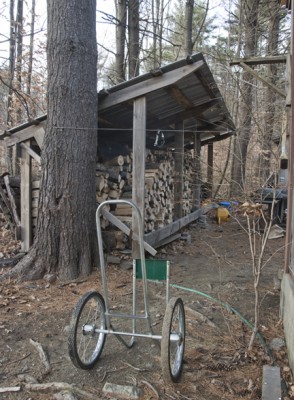
The Necessity of Good Hydration
Short and anecdotal, this one. Perhaps I need a new category - TMI (too much information) I live in a small, poorly insulated house with a wood stove for heat. The wood stove is rather small and fits in a stone fireplace. The stove is also fairly new and efficient but really doesn't hold a fire all night. So.... In the winter when the nights are cold I have a “system”. In order to insure that I wake up at least once during the night to feed the fire I make sure to drink lots of water before I go to bed. The ramifications of neglecting to do this are chilling. And it keeps me nice and healthy too.
Budget lessons for the architect (me)
Here is an interesting lesson to learn if I can figure out what it is. Perhaps writing this blog entry will help.I tend to attract the sort of client who wants a 2500 square foot house with porches, hardwood flooring, granite countertops and an attached garage and wants it for $275 K. If they don't flee the office in disgust when I tell them A: can't be done and B: my fees would definitely be more than $3000. (There will of course be someone who will “say” they can) What has happened too often to ignore in the past several years is that clients have come to me with a set of parameters (we architects refer to this as a program) The program consists of needs, wants, site and zoning issues, budget etc. Usually the budget requires a rethinking of needs vs wants and this is where things can get sticky. As I mentioned above, there will always be someone who will tell them they can have it all (meaning: let's wing it) and some clients will seek them out. A few years later when I see the project completed without me it is clear that either the budget was much more “flexible” than it was when they originally came to me or the “needs” list was pared down much more than what I was able to accomplish with them. I know I am not the best salesman, hoping instead that my obvious experience, references and air of quiet competence will engender trust (insert emoticon here) (real men don't use emoticons) There have been times when I have thought of a great solution to a design problem but scrapped it because it was a budget buster only to find out later when the clients went to another architect who came up with the same idea and “sold” it to the client. Discouraging. Perhaps the lesson is that I should take things a bit less personally and realize that other people's idea of budget is more flexible. Of course, I am often the second architect on a project because the first architect designed something too expensive to build...
Putney School - continuing education
Last night I attended a tour at the Putney School in nearby Putney VT to get some continuing education credits and to see some of the new buildings from their architect's perspectives. The tour itself was rather slow but having my daughter with me for the first half hour livened things up a bit. She may attend that school when she is older as my town has school choice after 8th grade and the school has an excellent network of x-c trails nicely groomed in the winter. There were no local architects in attendance other than Joe Cincotta and my friend from college who work up the river at Bensonwood. Boy do I not fit in in a group of older white male architects with the occasional shiny and polished female architect. I really must get some rectangly glasses. Are there any local architects anymore? It seems like all the good work is scooped up by firms from up North. In any case, the Putney Field house is a net nada, LEED unobtainium building that is very nice on the inside (I want one) but rather dull looking on the outside. I just really wanted to grab a basketball and shoot some hoops. There was a ski waxing room however and some Concept II's.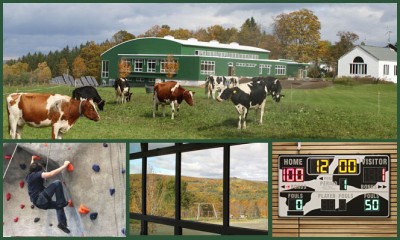
I really like the Michael S Currier Arts center. 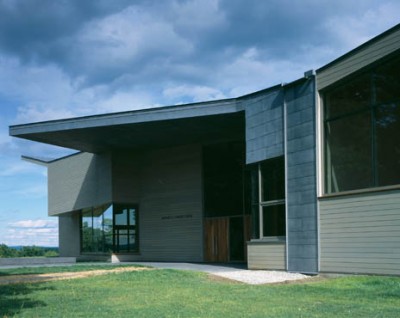 This a modern building that exudes grace and elegance..and it works well too. Details are nicely worked out on a level from the overall to minute details.
The hot link is to a bunch of photos on the Putney School website. This is the sort of building that makes me wish I worked for a larger firm doing institutional and commercial projects. It is very difficult to get this sort of work when you are an anti social sole proprietor lone artist sort who spends all day staring at a computer and muttering.
This a modern building that exudes grace and elegance..and it works well too. Details are nicely worked out on a level from the overall to minute details.
The hot link is to a bunch of photos on the Putney School website. This is the sort of building that makes me wish I worked for a larger firm doing institutional and commercial projects. It is very difficult to get this sort of work when you are an anti social sole proprietor lone artist sort who spends all day staring at a computer and muttering.
the cost of power
Living in New England I do get tired of the rampant NIMBYism that goes on here. Wind power is a perfect example. We would rather get our power from coal and let other people deal with all the mining related issues which seem to me to be far more serious than the negative issues associated with wind. Most of those people who have to deal with the negative issues related to coal are poor and so they have much less political power than us middle class New Englanders. I suspect most of them would be happy to get their mountains back and put turbines on the ridges.

Sizing a New House
Most clients say they want either a bigger house because they have kids or a smaller house because the kids have left. It has been my experience over the past few years that 2000 square feet is unacceptably small for most clients. Unfortunately, I most love designing houses in the 1200 to 1800 square foot range. Mostly, people either have too much stuff (oh the stuff I've seen) or are simply used to a large house. Try fitting the retired couple into a 2000 square foot house when they have just spent the last 40 years in a 3000 square foot house. They may initially like the idea but when it comes right down to it, they can't make the mental adjustment. Even if I come up with a floor plan that functions much better than what they have been living with.
Modern vs Conservative (neo-traditional)
Just a small thought. Perhaps I should collect more along these lines. "traditional" design (which is usually not actually very traditional) seems to limit one to creating spaces that are "nice" and "pleasant" and "functional" which is enough for some people. But it is hard, especially when faced with a fantastic view or outdoor space, to create a space with amazing emotional impact within the confines of traditional design.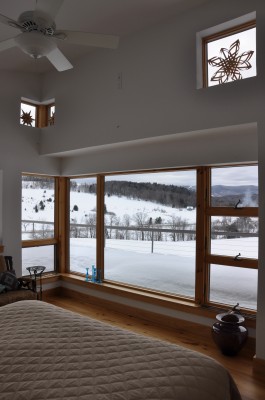
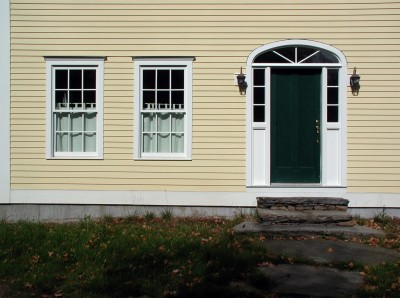
Know When to Run
My architect colleagues will do some nodding here.Sometimes you have to know when to run screaming from a project or risk losing your shirt to someone who probably makes six times your income. -If I client is in a hurry, step away -If a client refuses to divulge budget numbers, back away -If a client has unrealistic expectations and refuses to listen to reason, turn and start walking -If a client wants something for free run for your life! The mistake I have made in the past is thinking I can change someone. If this sounds like the stereotypical doomed personal relationship then BINGO. I am limited in my abilities to educate a potential or new client as to the architectural process and rely on references in the form of previous clients and builders (I always give out a list) If after all this, it is clear that the client hears what they want to hear and nothing more or less than it is time to exit stage left. An example: A few years ago I was hired to do an addition to an old Vermont cape. The addition was to have a large family room, two studies, a bedroom suite with closets and bathroom, a utility room, a porch etc etc. This is a LOT of square footage. I found that I could make a floor plan that made them happy but the resulting massing and scale was far off no matter what I did. I got fired from the job and lost my shirt to someone who can not only afford a second home in Vermont but can afford to renovate and add on. Mental note: future Woe-Is-Me post – why didn't I become a New York architect so I could afford to live in Vermont. In retrospect, I realized that what they were looking for visually was irreconcilable with what they wanted for a program (the floor plan spaces) The addition was to replace a small shed ell which was quite cute and a good match for the old cape and my job was to make the new addition just as small and cute despite containing 4x the space. Impossible. There will always be someone else who will tell them they can do it. Either an architect or designer who is a better salesperson than me and will do fanciful renderings with lots of flowers that make it look okay or a builder who will say “lets just figure it out as we go” and exude confidence all over the place. Yuck. I must assume they found such a person.
What architects don't know
Architecture is one of those professions where the more you know the more you know you don't know. Many architects don't know this. There are some who “float” and others who are in a constant state of continuing education. I am reminded of this by the large number of architects who state on their websites “We have always been green” but then you look at their projects with a trained eye and see otherwise. Geothermal heating or solar Photovoltaics on a house with 2 x 6 walls, probably insulated with fiberglass batts is an infraction I commonly see. Those architects who read this and don't see the hyppocracy in this example would be the example of “floaters”
900 s.f.
My own home is 900 s.f. with two bedrooms and a bathroom. We have lived there for 9 years. There are occasional mini-crisis over the one toilet. and I would like a large kitchen than the 9 foot "new york kitchen" we have. Also a mudroom would be nice. We will add on someday and double the size of the house. I rarely let clients see my home because after moaning to me about how their own 2000 s.f. house is way too small and they need more space, they might get embarrassed and "disappear" We invested in a really good sleeper sofa - it is our guest bedroom.
Greening your Neighbors
I just stuck this post over at GreenBuildingAdvisor.com This is more of a musing than a question. When building a new home would it be more environmentally responsible to forego the triple glazed windows and put the saved money into insulation upgrades on neighbor's houses? 10 or 20k would go a long way. Likewise, who is greener? someone who builds a net zero house with 40k of PV. or someone who donates 40k to weatherization programs or even buys 4 solar hot water systems for four neighbors?
Designing for Re-Sale
I don't run into this phenomenon as often as I suspect my more urban counterparts but when I do, it is disturbing. People put all their hopes and dreams about their new home through the filter of what the next owner will think. Or worse, a set of requirements their realtor or builder is telling them they must have for the house to re-sell. A rather obvious assumption here is that the real estate market will not come out of the feedback loop it is currently in although all signs are pointing towards that happening soon and in a big way. Will what sells in 2009 be the same as what sells in 2029? I don't think so. Never having been in this position personally, maybe I'm missing something in the psychology of it all. Maybe people are watching too much TV. I suppose I should add "duh" here. Quite a number of articles have come across my desk recently about how "boomers" in particular but also "millenials" and other age groups are demanding smaller more economical and efficient homes in exponentially increasing numbers. The large scale builders are taking notice and adjusting to accomodate. I guess cleaning three or four bathrooms every week gets old. - remind me to explain my butts to toilets ratio theory of American economics - remind me to invent one to explain.
11/5 Time article ran across this good article about market forces on home size - Downsizing
Windows
Some notes on windows to be filed under "opinions and musings".In the past several years I have designed some houses with large window quantities although not necessarily in terms of the area of glazing to floor area ratio. I often use lots of smaller operating windows and some large fixed windows, often mulled together so they install a one unit. Usually there is some push-back from the client because the number of windows is a clearly quantifiable beast which makes it fair game for the budget axe. Windows (fenestration) are much more difficult to get right than floor plans so I spend a disproportionate amount of time and worry getting them right. Typically the contractor will point out that "there are an awful lot of windows" in this project and the client will then come to me and ask "why" and can we "lose some windows?". Tough thing to hear after putting in so much effort to get them right. The window budget typically represents about 5% of the overall so it is not really a big deal. And also, and typically, (grumpy sputtery architect time) triple glazed windows are completely out of the question because when it comes right down to it, people care about the environment until it affects their granite countertops or 4 bathrooms or huge bedrooms (another blog another day) I have had the satisfaction over the past few years of having the clients understand and appreciate the window decisions I made during planning when they see the real thing built. Sometimes the client will even add a window or two.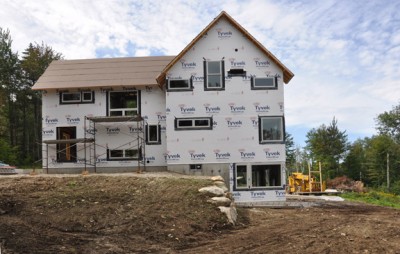
Eastern-vs-Western here in VT
This is something I run into fairly often. I am asked to design a home in a location that has a beautiful view and the client wants every room to have equal share of that view. Oh, and nothing may obstruct that view (trees, porch posts, mullions in windows, other parts of the house). Booooring. It is much more lively and interesting to break up a big view into vignettes so that the various locations in the house have variable relationships with the view. This is much more a part Eastern landscaping philosophy than the Western expansionist ideal. (which often includes random acts of shrubbery) The eastern philosophy says that the view starts at the end of your nose and extends to infinity. It also includes what you don't see but know is there. The Western view is "I need to see as much of the mountains as possible from every room in the house (and outside). Those trees are in the way - off with their heads". Side note: I heard that Tim Burton is working on an "Alice in Wonderland" movie! There should be one spot that takes it all in but this should be a place that you have to go to so the view doesn't become a part of the humdrum of everyday routine. This is just a small philosophical lecture that I usually lose in the end but I thought I'd write it down and file it under "mutterings"
NESEA Workshop in Brattleboro
Yesterday I attended a workshop put on by NESEA, the Northeast Sustainable Energy Association entitled "Residential Retrofits for Energy Efficiency and Sustainability" by Larry Harmon. Usually I have to travel to Boston or Burlington to attend these which can be costly and time consuming so it was nice to have one a mile down the road from my offices. There was a lot of good information and Larry is an engaging speaker. The big things that I came away with were the reinforcement of what I have been learning about air sealing, venting, and insulation. 1-Seal completely before adding insulation. - Most contractors or architects probably don't grok the importance or level of thoroughness that is required here or realize the ramifications of doing a less than perfect job. It is not just about energy loss and heating bills. It is very much about how to make a house that will last 100 years or more. There was much discussion and many slides of imperfect air sealing jobs and how they acellerated rot and mold problems.
2-Don't ventilate your roof! That was so 80's and 90's. Now, ten or more years later we get to see the nasty ramifications of venting your roof. yuck!
There was a lot of other information which I may add in here over the next few days and some of which was rather techy involving cost analysis calculations and BTU's and therms, (oh My!)
What disturbed me as it often does at these events is the lack of local builders in attendance. Of the 10% of local builders who care about building science and sustainbility issues, very few will go much further than a subscription to JLC. I'm afraid that if I go out there and draw up plans for a house with an unvented roof or create specifications for enhanced air sealing, builders will simply refuse to follow the plans and convince the homeowners that the architect (me) is full of it. It's an issue that I'm sure a lot of other architects face as well. Although I suspect that 90% of architects don't really care about such things either.
Added the next day in response to a comment.
The presenter showed lots of slides of what happens when you leave a pencil size hole in the sealing of the attic before adding insulation. Basically air pressure turns it into an moisture laden air nozzle. All the moisture then condenses (dew point) on the sheathing and rots it through fast. Or it freezes on the underside of the sheathing then rains down on the insulation when it thaws. Ventilation compounds this pressure effect. The best method seams to be to bypass all these issues and spray the underside of the sheathing with closed cell foam which is what I specify on new construction and treat the attic as conditioned space. Loose fill cellulose or fiberglass batts lose much of their insulating value when exposed to air movement. Many independent tests in recent years have shown the temperature on the underside of the roof does not vary due to ventilation or no ventilation. There were also slides of what happens when insulation is added to an existing house attic that previously had no problems other than high heat bills. Suddenly the attic was cooler, the dew point moved to inside the attic and rot set in almost immediately. board sheathing holds up better than plywood which holds up better than osb.
I get the feeling that as building science matures, ventilated roofs will become a way for architectural historians to date houses to a specific time period in the late 20th century and early 21st century.
Ramblings
This may come off sounding like more of a personal diary entry but oh well. I have an intern arriving in a few weeks to work for me for the summer. (woot!) I am both exited by and nervous about the whole prospect. I need to write down a plan of action including my expectations. I have never before been an employer so to a great extent this is new territory for me. I have been in a supervisory role both in an office setting and as a carpenter and those situations always went well. (insert the usual grumbling about having to train someone who is relatively clueless but earning much more than me) I am hoping that the experience will be not only fun and profitable but force me to introduce more rigor into my working habits. If I have to be more organized for him then I will have to be more organized myself and I could always use more of that. I tend to be highly productive but disorganized in my workflow plans. I have lots of work but of course I am worried about it all drying up instantly. I would love to get another whole house commision or super cool, green and mod addition/renovation right now but will be fine if I don't. That's all, I have go to hang up all my awards and distinctions and diplomas etc. to properly impress and intimidate the intern when he arrives.
On a side note, I have been reading lots of case studies about architectural firm startups and have discovered that I am doing it all wrong!
house size - my rules
okay, lets see if this can get me into a few good arguements!my square foot standards for house size: Tiny < 750 Small 750-1500 medium 1500-2500 LARGE 2500-5000 immoral and irresponsible >5000
I would perhaps make an exception to the last category for adopting a large quantity of children.
I like to throw about the term "functional square feet" I hate it when people come to me with a list of specific room sizes. I also don't mind designing a large house when I know it's going to be filled with children and in-laws and parties. If you try to design too small, you get into the issue that the house may not be flexible enough. Hopefully the house will be around a few hundred years and who knows what families will live there. If you design a 1200 square foot house that fits the current client perfectly, what happens 20 years down the road when somebody else adds on? I would rather focus on the idea that a good house should: 1. last 300 years 2. use very little energy to maintain / heat / cool 3. be flexible enough in plan to adapt to a wide variety of occupants, not just the current ones. 4. be responsible in materials usage. No granite from half way across the country, No non FSC tropical wood etc. The actual size is secondary to all these.
December 09 update: When I travel to Maine for family shindigs, I find myself looking at all the "housing stock" between here and there. about 30% of houses are under 1200 s.f. or so and have 1.5 bathrooms max. I then start to think about all the large happy families raised in these small homes, kids sharing bedrooms, waiting for the toilet etc. Clients who come to me - whether they have any money or not - all would be horrified at the thought of their kids sharing a room or sharing a bathroom with their kids or "guests" or not having an "away room" (thanks Sarah Susanka) It is the sad state of where our culture has taken us. I suppose one could say that being an architect isolates me from the lower financial half of society.



